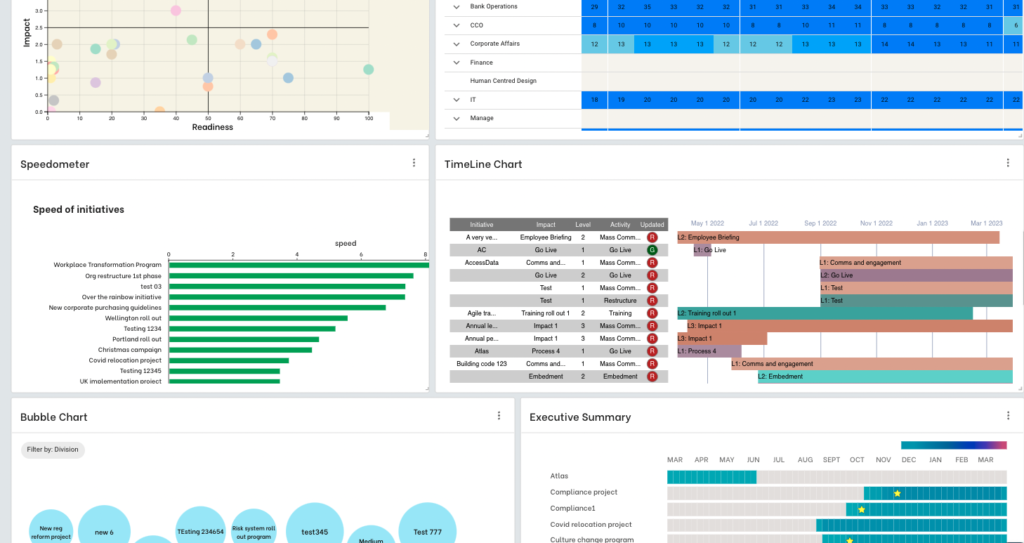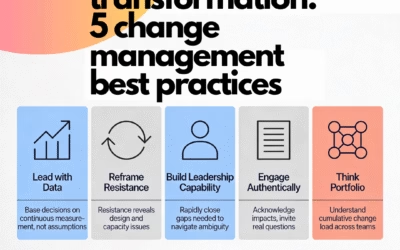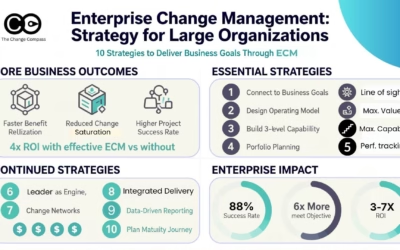We’ve all heard about how change is the only constant and that change is intensifying and not going away. On top of increasing digitisation, we have Covid, extreme weather disruptions as well as other company changes. Not all changes can be planned for. Change is a balancing act, requiring significant skill and management. The analogy comes to mind of a spinning plate circus act. Each plate needs attention and constant spinning. The problem is when you have 10, 50, or 100+ plates, it becomes almost impossible to pay attention to every single one across the company.
This is exactly why it is so critical to have a single view of change. When you are only spinning a few plates you can easily see them all and have enough attention and bandwidth to ensure they are all spinning effectively. When the number and intensity of change multiply, this becomes tricky. Without a single view of change, how can any organisation manage change across the board? This is exactly the problem.

For most companies, each project team is organised as a separate team, with a separate set of stakeholders. Multiply this by the number of projects and you get the problem. The number of silos that is each project creates significant complexity for the organisations. These include:
- At any one time, there will be multiple projects impacting the same part of the business. Since each project is only focused on its activities, they are mostly not aware of project activities from other projects that are impacting the same stakeholders.
- For the same group of stakeholders, there may be very different ways of engagement and change journeys required. Too many different types of change can make it difficult for the impacted stakeholders to digest. Also, these changes, when combined, may or may not support the business objectives of that particular part of the business.
- Some PMOs try to contain this complexity by creating different portfolios in which to group projects. The thinking is that each of the portfolio managers can manage a set of projects and can try to help join the dots where possible to coordinate the various releases and implementation of projects within each portfolio. However, managing too many portfolios can create even more complexity and thereby be less agile for the organisation. Also, most project portfolio managers are typically focused more on technical activities and releases, and less on resultant people impacts.
Why create a single view of change?
1. Change saturation and limited capacity
The first reason for creating a single view of change is to assess the risk for and avoid change saturation. There is evidence from several surveys including that from Prosci showing that change saturation/fatigue is one of the biggest challenges for organisations in changing. The pressure to change fast and still maintain business performance is real and impacts a wide range of industries.

2. Business capacity.
Even if there was not a risk of change saturation and fatigue, there is constantly a challenge of limited business capacity to change versus ‘keeping the lights on’ activities or executing business-as-usual tasks. This includes both the capacity to change for those impacted by the change, and also for subject-matter-experts from the business who may be pulled by multiple projects and thereby have limited bandwidth.
3. Change portfolio management
The first 2 points are of a business lens, in terms of business-related change impacts across projects. However, from a change portfolio perspective, it also makes sense to have a single view of change to better manage a change portfolio.
What is offered by a single view of change that is meeting a gap with the data captured by existing PMO is, change impact. This change impact includes types of stakeholders, roles, the parts of the organisations, and how they are impacted by the change. Data may capture the extent of the change effort required, the time required to undergo change activities, and even behaviours required as a part of the transformation.
With a single view of change, the project portfolio can be better managed in terms of:
- Project change resource allocation
- Project release coordination and harmonisation and how they impact stakeholders
- Change execution design across projects
- Examine opportunities to create ‘change bundles’ where it makes sense, or to break down change releases into smaller pieces if that is a better fit for the business
- Monitor operational risks across change releases
4.Change adoption
The ultimate goal of creating a single view of change is to maximize change adoption across the board. An impacted stakeholder group is likely going to experience multiple changes. If there is a way to design a change adoption process that makes it easier for the stakeholders it will significantly increase the likelihood of achieving full change adoption.
As a real example, at a major bank, the same group of stakeholders was asked by one project led by the Product division to prepare for the end of life of a credit card. They were asked to tell customers that this card will not only be sold after a certain date. On the other hand, another project led by Marketing was telling the same groups of stakeholders to sell more of this credit card to try and meet their quarterly target. Needless to say, this type of confusing message will not serve well to achieve any of the project change adoption targets.
5. Risk in change
Change risk management is an emerging discipline and growing in importance for Chief Risk Officers. This is particularly the case for financial services corporations. Risk in change is about how the organisation manages the risks by undergoing the committed changes in a way that allows them to operate safely. A key challenge is the visibility of the various changes presented in a way that allows the business to visualise these changes to be able to see the associated risks. A single view of change can add significant value from a risk lens.
If having a single view of change is so critical why is it that not more organisations have this? Here are some key reasons:
- Perceived difficulty in capturing a single view of change. Most change practitioners will think of the vast number of projects that need to be engaged to create this view and the time it takes to do this.
- How to capture the single view of change. With the various types of data available in each initiative some get overwhelmed and are not able to pinpoint exactly what information is required to be captured.
- How to report on a single view of change. Most opt for a simple traffic light showing red, amber, and green of the varying levels of impact of each project. The problem is that this is not always based on data (instead, based on personal judgment), and is often not quite granular enough to make this useful.
One of the key benefits of a single view of change is that it is critical in supporting the work of managing a change portfolio to make the right decisions to manage change holistically. To find out more about how to calculate the financial benefit of managing a change portfolio visit our article here.
Solution on building a single view of change quickly
There are several approaches to building a single view of change quickly. As a first step, it’s important to define what outcome is required and how the artifacts might be used to make impactful business decisions. Focus on capturing the impact of change per initiative as a starter, detailing different levels of impact of the initiative based on actual impact activities of each initiative, versus using high-level personal judgment (which may be hard to defend in front of senior managers).
1. Focus on one part of the business to capture a single view of change
It’s important to note that a single view of change should always be showing the view from the business stakeholders’ perspective, versus from a project/program perspective. A way to kickstart the process with a more achievable target is to select one part of the business to start focusing on. Ideally, choose a part of the business that is concerned about change volume and would like to use the reports developed with a single view of change.
Ensure you get these stakeholders onboard, and involve those who ‘feel the pain’ of change complexity. These stakeholders can be your change champions in supporting the development and utilisation of a single view of change.
2. Focus on a smaller set of initiatives as a start
Again, rather than trying to capture every initiative in one go, start by selecting a group of initiatives, either within a portfolio or a large program. It can also be that you start by focusing on the more ‘strategic initiatives that are of higher visibility to stakeholders. These initiatives are also easier to define.
3. Conduct workshops to quickly gather data
One of the best ways to collect data quickly is to gather these in structured workshops. In each of the workshops you have a representative from each project attending, either a change manager or a project manager. In the workshop, you talk through the data you are trying to capture and work with the group to capture them. During the session, it is also a good idea to view the data collected and clarify as needed to ensure the data is spot on.
It is a good idea before the workshop to provide a simple template for participants to do the pre-work, identifying the change impact activities for their respective projects. Be clear in defining what these change impact activities mean, providing examples to show them the types of data you are after.
Here is a sample timeline for creating a single view of change:
Week 1: Align with sponsors and senior stakeholders on the ‘why’ of creating a single view of change
Week 2-3: Conduct workshops to collate data cross initiatives
Week 4: Create data visualisation and share with stakeholders
3. Utilise digital tools to automate and speed up the process
Using an Excel spreadsheet may be a good way to go in the beginning, but for organisations that have a digital focus, leveraging digital tools make perfect sense. Using change management tools that help you piece together a single view of change with all the fields and reports already built can save significant time and effort. With the ease of support for ongoing data collection, and reporting significant time and resources are saved. In addition, a good tool can help provide additional insight into what is happening to the organisation that manual ways may not generate. The ability to add significant value through data-backed insight that can significantly influence change implementation is one of the key advantages of leveraging a digital tool.

Moreover, a single view of change should not be a static artifact. Instead, it should be a live data source that is constantly changing as the organisation undergoes various changes. In a fast-paced change environment, it is even more critical to have the right digital tool to provide clear tracking and reporting.
Practical Tips and Strategies for Implementing a Single View of Change
Implementing a single view of change requires a systematic approach and careful consideration of various factors. Here are detailed practical tips and strategies to facilitate the process:
- Define Clear Objectives:
- Start by clearly defining the objectives of implementing a single view of change. Determine what outcomes the organization hopes to achieve, such as improved coordination, enhanced decision-making, or increased change adoption rates.
- Ensure that the objectives are specific, measurable, achievable, relevant, and time-bound (SMART), providing a clear roadmap for implementation and evaluation.
- Engage Stakeholders:
- Conduct Impact Assessments:
- Conduct comprehensive impact assessments for each change initiative to understand its potential effects on stakeholders, processes, systems, and the organization as a whole.
- Identify and analyze potential conflicts, dependencies, and overlaps between projects to mitigate risks and ensure effective coordination and alignment.
- Utilize tools and methodologies such as stakeholder analysis, risk assessment, and change impact analysis to gather and analyze relevant data.
- Utilize Change Management Tools:
- Leverage change management tools and technologies to streamline the process of capturing, analyzing, and managing change data.
- Choose tools that align with the organization’s needs and capabilities, providing features such as data visualization, workflow automation, collaboration, and reporting.
- Train users on how to effectively utilize these tools and provide ongoing support and maintenance to ensure their optimal functionality.
- Establish Clear Communication Channels:
- Establish clear communication channels and protocols for sharing information, updates, and feedback related to change initiatives.
- Implement regular meetings, newsletters, intranet portals, and other communication tools to keep stakeholders informed and engaged throughout the implementation process.
- Encourage two-way communication, soliciting input and feedback from stakeholders and addressing any concerns or questions in a timely and transparent manner.
- Provide Training and Support:
- Offer comprehensive training and support to employees and stakeholders to help them navigate and adapt to change effectively.
- Develop and deliver training programs, workshops, and resources focused on building change management skills, resilience, and readiness.
- Provide ongoing support and guidance to individuals and teams as they navigate the complexities of change, offering coaching, mentoring, and access to relevant resources and expertise.
- Monitor and Adapt:
- Continuously monitor the effectiveness of the single view of change implementation and be prepared to adapt and refine strategies as needed.
- Establish key performance indicators (KPIs) and metrics to track progress, measure success, and identify areas for improvement.
- Solicit feedback from stakeholders and project teams regularly, incorporating insights and lessons learned into ongoing iterations and updates of the single view of change.
- Engage key stakeholders from across the organization in the process of establishing a single view of change. This includes representatives from project teams, senior management, frontline employees, HR, IT, and other relevant departments.
- Foster open communication and collaboration among stakeholders, encouraging them to share insights, concerns, and feedback throughout the implementation process.
- Consider forming a dedicated change management team or steering committee to oversee the implementation and ensure alignment with organizational goals.
By implementing these practical tips and strategies, organizations can establish a robust and effective single view of change that enhances coordination, alignment, and success in managing change initiatives across the organization.
Addressing Potential Objections or Challenges
While implementing a single view of change offers numerous benefits, organizations may encounter objections or challenges along the way. Here are detailed strategies for addressing common concerns:
- Resource Allocation:
- Address concerns about resource allocation by conducting a thorough assessment of the time, budget, and personnel required for implementing a single view of change.
- Prioritize resources based on the strategic importance and potential impact of change initiatives, focusing efforts on high-priority projects with the greatest potential for success.
- Consider leveraging external expertise or resources, such as consultants, trainers, or change management professionals, to supplement internal capabilities and ensure successful implementation.
- Resistance to Change:
- Proactively address resistance to change by fostering a culture of openness, transparency, and collaboration within the organization.
- Communicate the rationale behind the single view of change initiative, highlighting the benefits and opportunities it presents for stakeholders and the organization as a whole.
- Provide training, education, and support to help employees and stakeholders understand and embrace the changes, addressing concerns, fears, and misconceptions along the way.
- Involve stakeholders in the decision-making process and empower them to contribute to the development and implementation of the single view of change, fostering ownership and commitment to its success.
- Organizational Culture Barriers:
- Recognize that organizational culture can influence the success of change initiatives and take proactive steps to address cultural barriers.
- Assess the current organizational culture and identify any values, beliefs, or norms that may hinder the adoption of a single view of change.
- Align the implementation of the single view of change with the organization’s values and cultural priorities, emphasizing collaboration, innovation, and continuous improvement.
- Engage cultural change champions and influencers within the organization to champion the initiative, build momentum, and overcome resistance to cultural change.
By proactively addressing potential objections or challenges, organizations can mitigate risks and obstacles to implementing a single view of change, paving the way for greater success and effectiveness in managing change initiatives.
In conclusion, establishing a single view of change is not merely an advantageous undertaking for change practitioners; it’s a fundamental necessity for navigating the complexities of modern organizational change. When executed effectively, a single view of change has the potential to significantly enhance the management of change portfolios and drive higher levels of change adoption across initiatives.
While the process of gathering and organizing data for a single view of change may seem daunting, structured approaches such as workshops can expedite this process, allowing organizations to achieve results within weeks rather than months.
However, it’s essential to recognize that a single view of change should not be viewed as a one-time endeavor. Instead, it should be embraced as an ongoing process, continuously evolving to meet the dynamic needs of the organization. By consistently generating engaging and impactful data visualizations, organizations can leverage their single view of change to glean valuable business insights and inform strategic decision-making.
In essence, a single view of change isn’t just a tool; it’s a transformative capability that empowers organizations to thrive amidst the ever-evolving landscape of change.
If you are about to embark on creating a single view of change and are thinking about whether or how to leverage a digital offering to support your efforts reach out and have a chat with us.






